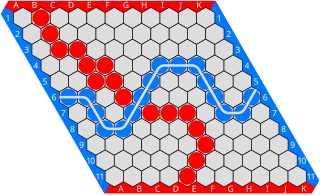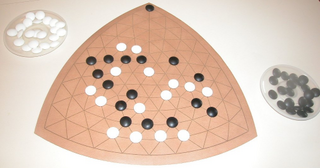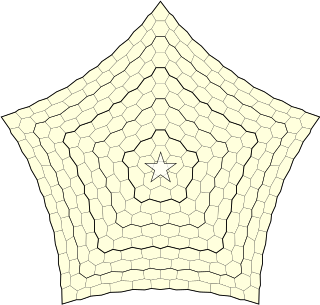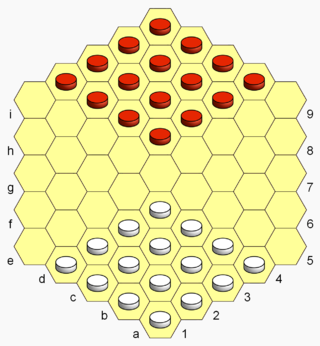
Reversi is a strategy board game for two players, played on an 8×8 uncheckered board. It was invented in 1883. Othello, a variant with a fixed initial setup of the board, was patented in 1971.

Hex is a two player abstract strategy board game in which players attempt to connect opposite sides of a rhombus-shaped board made of hexagonal cells. Hex was invented by mathematician and poet Piet Hein in 1942 and later rediscovered and popularized by John Nash.
In computational complexity theory, a decision problem is PSPACE-complete if it can be solved using an amount of memory that is polynomial in the input length and if every other problem that can be solved in polynomial space can be transformed to it in polynomial time. The problems that are PSPACE-complete can be thought of as the hardest problems in PSPACE, the class of decision problems solvable in polynomial space, because a solution to any one such problem could easily be used to solve any other problem in PSPACE.

Checkers, also known as draughts, is a group of strategy board games for two players which involve forward movements of uniform game pieces and mandatory captures by jumping over opponent pieces. Checkers is developed from alquerque. The term "checkers" derives from the checkered board which the game is played on, whereas "draughts" derives from the verb "to draw" or "to move".

Kensington is an abstract strategy board game devised by Brian Taylor and Peter Forbes in 1979, named after London's Kensington Gardens, which contains the mosaic upon which the gameboard is patterned. It is played on a geometrical board based on the rhombitrihexagonal tiling pattern. The objective of the game is to capture a hexagon by occupying the six surrounding vertices. The game maintains an elegant simplicity while still allowing for astonishingly complex strategy. The placing and movement of tokens have been compared to nine men's morris.
The pie rule, sometimes referred to as the swap rule, is a rule used to balance abstract strategy games where a first-move advantage has been demonstrated. After the first move is made in a game that uses the pie rule, the second player must select one of two options:
- Letting the move stand. The second player remains the second player and moves immediately.
- Switching places. The second player becomes the first-moving player with the move already done by the opponent, and the opponent plays the first move of their new color.

Y is an abstract strategy board game, first described by John Milnor in the early 1950s. The game was independently invented in 1953 by Craige Schensted and Charles Titus. It is a member of the connection game family inhabited by Hex, Havannah, TwixT, and others; it is also an early member in a long line of games Schensted has developed, each game more complex but also more generalized.

TwixT is a two-player strategy board game, an early entrant in the 1960s 3M bookshelf game series. It became one of the most popular and enduring games in the series. It is a connection game where players alternate turns placing pegs and links on a pegboard in an attempt to link their opposite sides. While TwixT itself is simple, the game also requires strategy, so young children can play it, but it also appeals to adults. The game has been discontinued except in Germany and Japan.
The Shannon switching game is a connection game for two players, invented by American mathematician and electrical engineer Claude Shannon, the "father of information theory", some time before 1951. Two players take turns coloring the edges of an arbitrary graph. One player has the goal of connecting two distinguished vertices by a path of edges of their color. The other player aims to prevent this by using their color instead. The game is commonly played on a rectangular grid; this special case of the game was independently invented by American mathematician David Gale in the late 1950s and is known as Gale or Bridg-It.
Combinatorial game theory measures game complexity in several ways:
- State-space complexity,
- Game tree size,
- Decision complexity,
- Game-tree complexity,
- Computational complexity.

*Star is a complex abstract strategy game by Ea Ea, a designer of Y. It is a redevelopment of his earlier game Star.

Christian Freeling is a Dutch game designer and inventor of abstract strategy games, notably Dameo, Grand Chess, Havannah, and Hexdame.
The Game of the Amazons is a two-player abstract strategy game invented in 1988 by Walter Zamkauskas of Argentina. The game is played by moving pieces and blocking the opponents from squares, and the last player able to move is the winner. It is a member of the territorial game family, a distant relative of Go and chess.

A hex map, hex board, or hex grid is a game board design commonly used in simulation games of all scales, including wargames, role-playing games, and strategy games in both board games and video games. A hex map is subdivided into a hexagonal tiling, small regular hexagons of identical size.
Star is a two-player abstract strategy board game developed by Craige Schensted. It was first published in the September 1983 issue of Games magazine. It is a connection game similar to Hex, Y, Havannah, and TwixT. Unlike these games, however, the result is based on a player having a higher final score rather than achieving a specific goal. He has since developed a slightly more complicated version called *Star with better balance between edge and center moves, writing "*Star is what those other games wanted to be."
A connection game is a type of abstract strategy game in which players attempt to complete a specific type of connection with their pieces. This could involve forming a path between two or more endpoints, completing a closed loop, or connecting all of one's pieces so they are adjacent to each other. Connection games typically have simple rules, but complex strategies. They have minimal components and may be played as board games, computer games, or even paper-and-pencil games.

Emergo is an abstract strategy game created by Christian Freeling and Ed van Zon in 1986. It belongs to the "stacking" category of games, or column checkers, along with Bashni and Lasca. The name comes from the motto of the Dutch province of Zeeland: Luctor et emergo meaning: "I wrestle and emerge". The goal of the game is to capture all of the opponents pieces similar to checkers/draughts. Emergo, and all column checkers, differ from most draughts variants because of their unique method of capture. An opponent's piece is added to the capturing player's column rather than being removed. Men can be recaptured from an opponent later on in the game.

Hexdame is a strategy board game for two players invented by Christian Freeling in 1979. The game is a literal adaptation of the game international draughts to a hexagonal gameboard.











